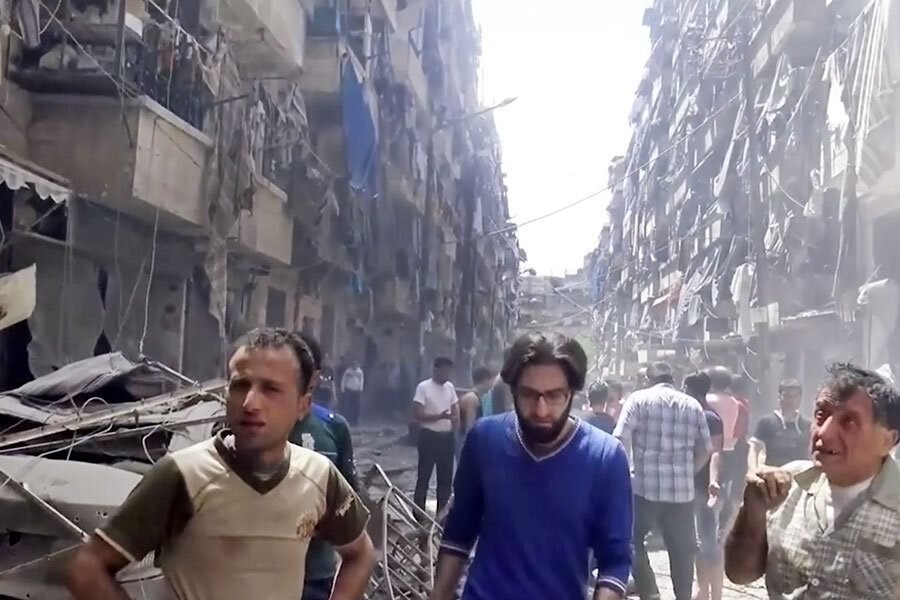Collapse of Syrian cease-fire a reprieve for Islamic State
Loading...
| Washington
The fraying of the two-month-old cessation of hostilities in Syria has meant a return of the aerial and heavy-weaponry attacks on civilians that have made the five-year-old civil war so deadly.
Yet as devastating as the collapsing cease-fire may be for Syrian civilians, the return of full-scale fighting between government forces and the various elements of the armed opposition has also been a boon to one group in particular: the self-described Islamic State.
The nine-week lull in fighting corresponded with some of the Islamic State’s most significant setbacks in Syria. One example is the recapture of Palmyra by government forces earlier this month.
A string of IS losses prompted some speculation that the momentum could soon lead to the terrorist group being routed from its Syrian headquarters in the city of Raqqa. That loss, it is thought, would signal an irreversible deterioration of the organization, also known as ISIS.
But now the unraveling cease-fire has Syrian government forces refocused on rebel strongholds – particularly on retaking Aleppo, Syria’s largest city. And that resurgence of the civil war is allowing IS some respite and potentially extending its lease on life, some analysts say.
“I think absolutely the principal beneficiary of the faltering of the cessation of hostilities is ISIS,” says Wayne White, a non-resident security expert at the Middle East Institute in Washington and a former deputy director of the State Department’s Bureau of Intelligence.
“They found themselves suddenly under more intensive pressure when the regime [of President Bashar al-Assad] shifted its sights from opposition forces,” he adds, “but now ISIS can regroup and try to reverse some of its losses as the fighting is redirected back” to rebel-held areas like Aleppo.
The shift is nothing short of a “reprieve” for the terrorist group, says Fabrice Balanche, a visiting scholar at The Washington Institute for Near East Policy (TWI).
Civilian toll
The fraying of the cease-fire, brokered by the United States and Russia, has also meant a return of the attacks on civilians that have pushed the war's death toll toward the 300,000 mark.
Early Thursday airstrikes on one of the few hospitals operating in the rebel-held sector of Aleppo killed more than two dozen people – including children and the city’s last remaining pediatrician. The hospital, which was widely known to be operated by Doctors Without Borders and the International Red Cross, was leveled.
On Friday, rebel shelling of government-held areas of Aleppo killed more than two dozen people. In all, more than 200 people, mostly civilians and including scores of children, have been killed during a week of resumed fighting in Aleppo, according to the Britain-based Syrian Observatory for Human Rights.
The attack on Aleppo’s Al-Quds Hospital in particular put a human face back on Syria’s war, as videos posted on social media – which had largely disappeared during the two-month cessation of hostilities – once again showed parents and children crying over slain relatives. The United Nations warned of a “catastrophic deterioration” of conditions in Aleppo that would deepen Syria’s humanitarian crisis if left unchecked.
On Friday, the Syrian government declared an undefined “regime of calm” to take effect overnight, first in areas of Damascus and Latakia province. The UN special envoy on Syria, Staffan de Mistura, announced plans to visit Moscow next week to try to rescue the cease-fire. The US State Department described the government's "regime of calm" as a "test" of whether a general cessation of hostilities could be revived.
United States officials condemned the Aleppo hospital attack, while suggesting more broadly that a return to fighting among Syria’s factions would benefit IS. At a congressional hearing Thursday on the US strategy against IS, Defense Secretary Ashton Carter said the terrorist organization depends on chaos to take root in an area and survive.
The US-led coalition has made progress against IS in recent months, including by restricting its financial resources and reducing its territory, Mr. Carter said. But any collapse of diplomatic efforts would mean a return of chaotic conditions that make defeating IS more difficult.
Syria's IS offensive 'on hold'?
During the past two months, the Syrian Army’s “redirect” toward a more aggressive posture on IS had raised hopes, Mr. White says. “Under the cessation of hostilities, the Army made the lunge out to Palmyra and it was looking like they could use that as a springboard to chop up ISIS territory and put them in peril,” he says.
Writing on the TWI website, Mr. Balanche says taking back Palmyra was only the “first step” in the Assad regime’s plan to regain control of the Euphrates Valley and cut off Raqqa from IS territory in Iraq. Now that plan appears to be on hold.
“If the focus returns to Aleppo and the northeast,” White says, “the pressure’s off.”
The desperate diplomatic efforts aimed at reviving the cessation of hostilities and moribund peace talks in Geneva raise concerns of a recurring pattern: fierce fighting followed by a brief, uneasy calm, as combatants alternate stabs at military advances with periods of regrouping and re-arming.
Such a pattern has occurred in other conflicts, experts say, from Lebanon in the 1970s and '80s to the ongoing civil war in Yemen. The pattern tells some analysts that, even as the war moves into its sixth year, a political resolution is still a ways off.
“The terrible pictures we’re seeing once again from this war will get the diplomatic effort going again. We might even see [Secretary of State John] Kerry rush off to Moscow, why not?” White says. “But that doesn’t mean you’re going to get something that can hold, because all the parties involved in this thing are quite far apart.”








